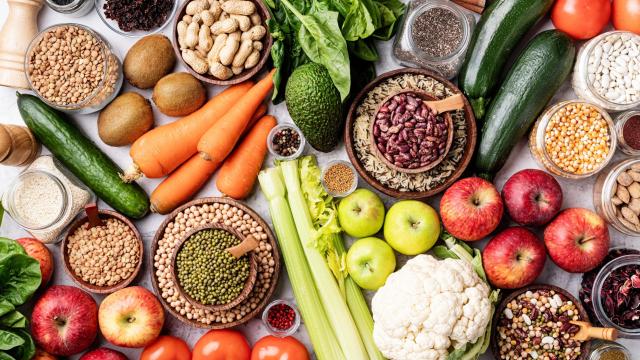I have some personal news: I went vegan about three or four months ago. Considering that I’ve written thousands of words about how much I love tofu and black bean burgers, this “news” is hardly shocking, but with meat discourse reaching furious new heights (or depths?) every day, it seemed too relevant not to share.
To be honest, this has been a long time coming. I’ve never been morally or ethically opposed to eating animals — I’m still not — but capitalism is another story, and at this point there’s no separating the two. You don’t need me to tell you that industrial meat production is an enormous contributor to global warming (and climate denialism) or that meat processing corporations are almost cartoonishly evil in their exploitation of an underpaid, often undocumented workforce. The facts are out there for the whole world to see, which is probably why more people are choosing to eat less meat.
But making the choice is easy; figuring out how to eat less meat is less so. What do you eat instead, especially when you’ve eaten meat your whole life? Whether you’re going fully vegan or just cutting back, these tips will help you find some answers.
Ask yourself the hard questions
OK, I lied a little — there are a few more questions before the answers. Big lifestyle changes should be cause for reflection, but if the idea of eating less meat still makes you uncomfortable, you owe it to yourself to ask why.
What are the downsides? Well, you’ll eat less meat. That’s pretty much it. Meat will still exist, of course, but most of the time you’ll just eat other stuff. Is that really a dealbreaker for you? If so, why? You can get protein and fat from a zillion other foods — do you have to have meat? Once you’ve thought about it a little, you’ll find your personal reasons, or you might realise that you don’t need meat at all, or at least not all the time.
Do a little brainstorming
The easiest way to eat less meat is to eat more of everything else. A good first step is to sit down and make a list of non-meat foods you already love. Don’t be afraid to take this assignment extremely literally: Even a list of 10 vegetables you like is valuable, and it’ll make meal planning easier.
Your list should not include foods that could be meatless with the right substitutes. Known quantities are fair game — like your favourite frozen vegetable dumplings or a great vegan burger from a local pub — but don’t count on fake meat to save the day, especially if you’ve never had it.
Get an air fryer
Oh my God, I can’t believe I waited until the year 2021 to buy an air fryer. It makes short work of every roasted vegetable you can think of, plus a wide variety of goodies like crispy tofu, extra-crispy potatoes, fried bread, frozen gnocchi, leftover fries, crispy shallots, and of course, frozen tater tots — and that’s just off the top of my head. Please don’t be a dummy like me: Get an air fryer before you give up meat.
Get really into beans
You probably saw this coming, but beans are a cornerstone of a meatless diet. This will be great news to some and a real downer to others — but if you’re not a big bean guy, try to keep an open mind. The world of beans is wider and more delicious than you might think.
Beans don’t have to come from a bag or a can, and you don’t even have to eat them whole. Tofu and tempeh are wonderful examples of the humble soybean’s versatility; falafel is just chickpeas and herbs in a convenient, deep-fried package. You can even make pancakes and fritters entirely out of beans: In Indian cuisine, chilla (or cheela) are pancakes made from either besan (chickpea flour) or soaked legumes that have been puréed into a batter. (If you soak the legumes with some rice and let it ferment, you’ve got dosa batter.) Korean cuisine has nokdujeong (or bindaetteok), a mung bean-based fritter stuffed with kimchi, bean sprouts, and scallions.
Broaden your horizons
Beans are just the beginning. For the majority of our time on earth, human beings have eaten anything but meat — which means we’ve figured out about a billion ways to make plants taste good.
Every cuisine on the planet has a rich tradition of meatless dishes, and you don’t have to dig very deep to find them. Whether you get them from YouTube or cookbooks (my two preferred sources), homestyle recipes from pretty much any culinary tradition will never steer you wrong.
My go-to dinner is usually either some form of homestyle Mexican food — beans, tortillas, salsa, potatoes, the occasional soyrizo — or literally any recipe from Priya and Ritu Krishna’s Indian-ish, the best cookbook of the decade. As always, seek out recipes created by people who are actually part of the culture they’re representing. The recipes will be better and you’ll learn more.
Buy more food
My final tip for eating less meat is super obvious but rarely mentioned: If you’re used to a meat-heavy diet, you’ll need to eat way more other stuff to make up for it. I’m not talking about nutrient macros — I’m talking sheer volume. A big steak is still a big steak after it’s cooked, but an enormous head of cauliflower can shrink down to a single serving in a hot oven. When you go grocery shopping, err on the side of buying larger portions than you’re used to, at least until you get a feel for your new normal. Something tells me that won’t take long.

Leave a Reply
You must be logged in to post a comment.